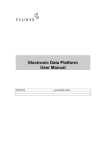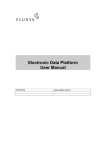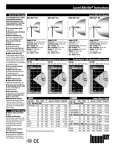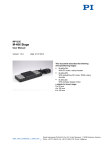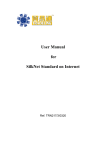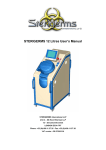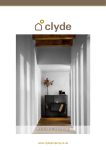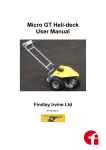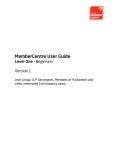Download Guide to Purchasing High Modulus Synthetic Fibre Mooring
Transcript
Oil Companies International Marine Forum Guide to Purchasing High Modulus Synthetic Fibre Mooring Lines First edition February 2014 The purpose of the Society of International Gas Tanker and Terminal Operators is to promote shipping and terminal operations for liquefied gases which are safe, environmentally responsible and reliable. The OCIMF mission is to be the foremost authority on the safe and environmentally responsible operation of oil tankers, terminals and offshore support vessels, promoting continuous improvement in standards of design and operation. ©Copyright OCIMF and SIGTTO 2014 Issued by the Oil Companies International Marine Forum 29 Queen Anne’s Gate London SW1H 9BU United Kingdom The Society of International Gas Tanker and Terminal Operators 17 St Helen's Place London EC3A 6DG United Kingdom First published 2014 © Oil Companies International Marine Forum, Bermuda © Society of International Gas Tanker and Terminal Operators British Library Cataloguing in Publication Data A catalogue record for this book is available from the British Library. The Oil Companies International Marine Forum (OCIMF) is a voluntary association of oil companies having an interest in the shipment and terminalling of crude oil and oil products. OCIMF is organised to represent its membership before, and to consult with, the International Maritime Organization and other governmental bodies on matters relating to the shipment and terminalling of crude oil and oil products, including marine pollution and safety. Society of International Gas Tanker and Terminal Operators (SIGTTO) is a non-profit making organisation dedicated to protect and promote the mutual interests of its members in matters related to the safe and reliable operation of gas tankers and terminals within a sound environment. The Society was founded in 1979 and was granted consultative status at IMO in November 1983. Terms of Use The advice and information given in the Guide to Purchasing High Modulus Synthetic Fibre Mooring Lines (the Guide) is intended to be used at the user’s own risk. Acceptance or otherwise of recommendations and/or guidance in this Guide is entirely voluntary. The use of the terms ‘will’, ‘shall’, ‘must’ and other similar such words is for convenience only, and nothing in this Guide is intended or should be construed as establishing standards or requirements. No warranties or representations are given nor is any duty of care or responsibility accepted by the Oil Companies International Marine Forum (OCIMF), the Society of International Gas Tanker and Terminal Operators (SIGTTO), the membership or employees of OCIMF, SIGTTO or by any person, firm, corporation or organisation (who or which has been in any way concerned with the furnishing of information or data, the compilation or any translation, publishing, supply or sale of the Guide) for the accuracy of any information or advice given in the Guide or any omission from the Guide or for any consequence whatsoever resulting directly or indirectly from compliance with, adoption of or reliance on guidance contained in the Guide even if caused by a failure to exercise reasonable care on the part of any of the aforementioned parties. ©Copyright OCIMF and SIGTTO 2014 Guide to Purchasing High Modulus Synthetic Fibre Mooring Lines Contents Glossary 3 Abbreviations 6 Bibliography 7 Introduction 8 1 1.1 Properties of high modulus synthetic fibre mooring lines 9 General 9 2 2.1 Factors that may impact the service life of high modulus synthetic fibre mooring lines 10 Considerations associated with the use of high modulus synthetic fibre mooring lines 15 Guidance for specifying high modulus synthetic fibre mooring lines 19 General 19 2.2 Rope application 19 2.3 Minimum breaking load 19 2.4 Diameter 20 2.5 Length 20 2.6 Rope construction 20 2.7 Material specification and certification 23 2.8 Marking and certification 23 2.9 Purchaser’s test requirements 24 1.2 1.3 2.10 Packing and delivery 24 2.11 After sales service 24 2.12 Purchaser’s requisition form 25 2.13 Quality control 25 Summary of considerations 26 2.14 2 ©Copyright OCIMF and SIGTTO 2014 Guide to Purchasing High Modulus Synthetic Fibre Mooring Lines Glossary Within this guide, the terms below have the following meanings: Abrasion resistance The ability of a fibre or rope to withstand wear and rupture due to motion against other fibres or rope components (internal abrasion) or a contact surface which can be a portion of the rope itself (external abrasion). Aramid fibre (also para-aramid) A manufactured high-modulus fibre made from a long-chain synthetic aromatic polyamide in which at least 85% of the amide linkages join two aromatic rings. Axial compression fatigue The tendency of a fibre to fail when it is subjected to cyclic loading which exerts compression along its axis. Braided rope Rope formed by braiding (intertwining) or plaiting the strands together as opposed to twisting them. Breaking strength For cordage, the nominal force (or load) that would be expected to break or rupture a single specimen in a tensile test conducted under a specified procedure. On a group of like specimens it may be expressed as an average or as a minimum based on statistical analysis. Creep A time-dependant increase in length while under a continuing load which is non-recoverable following the removal of the load. Creep rupture Creep rupture is failure of a material due to a sustained load that it less than the break strength of the material. Critical temperature The temperature at which the properties of a fibre begin to deteriorate. Cyclic loading Repeated loading of a rope or other structure in service or on a test machine. Design factor A factor that is used to calculate the recommended working load by dividing the minimum breaking strength of the rope by the design factor. The design factor should be selected only after a professional assessment of risk. Density The mass per unit volume. See Linear Density. Diameter nominal Approximate diameter of cordage used for naming or reference purposes. Any rapidly applied force that increases the load on a rope significantly above the normal static load. The temporary change in length of a fibre or yarn under tension which is reversed when the tension is removed. Dynamic load Elastic elongation Elasticity The elastic (non-permanent) elongation of a unit length of an element caused by a unit load. May refer to a material or a composite structure such as a mooring line. Elongation The ratio of the extension of a rope, under an applied load, to the length of the rope prior to the application of the load expressed as a percentage. End-for-end The process of rotating a rope or wire on its stowage drum so that the working section is changed. This involves removing the rope or wire from the drum and re-stowing it with the previous outboard end next to the drum. Extension The deformation (change in length) of a rope when a load is applied. Fibre A long, fine, very flexible structure that may be woven, braided, stranded or twisted into a variety of fabrics, twine, cordage or rope. Filament, continuous Manufactured fibres of an indefinite length, which may be converted into filament yarn, staple or tow. 3 ©Copyright OCIMF and SIGTTO 2014 Guide to Purchasing High Modulus Synthetic Fibre Mooring Lines High Modulus Polyethylene (HMPE) A polyethylene fibre produced by gel spinning of an Ultra High Molecular Weight PolyEthylene (UHMWPE) feedstock. Also called extended chain PE (ECPE) or high performance PE (HPPE). High Modulus Synthetic Fibre (HMSF) The generic term given to a range of fibre materials that include Aramid, LCP and HMPE fibres. Inspection, Tactile Manipulation of the rope by hand or other means to determine hardness and flexibility. Inspection, visual Examination of the exterior or interior of a rope by visual methods, which may include magnification. Laid ropes Ropes made by twisting of three or more strands together with the twist direction opposite that of the strands. Lay length Length along a rope for a complete revolution of a single strand in laid, twisted or plaited rope or cordage. Linear density The mass per unit length of a fibre, yarn or rope. Liquid Crystal Polymer (LCP) A class of aromatic polyester polymers. Minimum Breaking Load (MBL) The minimum breaking load of a new dry mooring line as declared by the manufacturer. For the purposes of this document, the MBL refers to that of a spliced rope. Plaited Rope A rope structure consisting of two pairs of strands twisted to the right and two pairs of strands to the left and braided together such that pairs of strands of opposite twist alternately overlay one-on-another. Pre-tension Additional load applied to a mooring line by a powered winch over and above that required to remove sag from the main run of the line. Size number A nominal designation of rope size, determined from the approximate circumference measured in inches, calculated as three times the approximate rope diameter. Splice The joining of two ends of yarn, strand or cordage by intertwining or inserting these ends into the body of the product. Strand The largest individual element used in the final rope-making process and obtained by joining and twisting or braiding together several yarns or groups of yarns. Stranding The process of combining a number of roping yarns by twisting to form a strand. Tail (pennant) A short length of synthetic rope attached to the end of a mooring line to provide increased elasticity and also ease of handling. Tension-tension fatigue Fatigue caused by cyclic axial loading at given mean load, load amplitude and frequency. Twist A rotation induced in the rope during service. Twisting The process of making rope in which two or more strength members (yarns or strands) are rotated together around a central axis. Wire-lay rope Rope made by stranding three or more strength members together in a helical pattern. Also called stranded rope. Yarn A generic term for a continuous strand of textile fibres, filaments or material in a form suitable for intertwining to form a textile structure via any one of a number of textile processes. 4 ©Copyright OCIMF and SIGTTO 2014 Guide to Purchasing High Modulus Synthetic Fibre Mooring Lines Yarn-on-yarn abrasion Wear that occurs when two or more yarns move against each other. 5 ©Copyright OCIMF and SIGTTO 2014 Guide to Purchasing High Modulus Synthetic Fibre Mooring Lines Abbreviations ECPE EUROCORD HMSF HPPE ISO LCP MBL OCIMF SIGTTO UHMWPE Extended chain PolyEthylene European Federation of Rope, Twine and Netting Industries High Modulus Synthetic Fibre High performance PolyEthylene International Organization for Standardization Liquid Crystal Polymer Minimum Breaking Load Oil Companies International Marine Forum Society of International Gas Tanker and Terminal Operators Ultra High Molecular Weight PolyEthylene 6 ©Copyright OCIMF and SIGTTO 2014 Guide to Purchasing High Modulus Synthetic Fibre Mooring Lines Bibliography The following publications and documents are referenced within the text: Reference 1 Mooring Equipment Guidelines (3rd Edition) (OCIMF) Reference 2 ISO 2307 (2010) – Fibre ropes – Determination of certain physical and mechanical properties. Reference 3 CI 1500 (Current version) – Test Methods for Fiber Rope Reference 4 ISO 9001 (2008) – Quality Management Systems In addition to the above referenced documents, the following publications are useful sources of additional information: ISO 1968 Fibre Ropes and Cordage - Vocabulary ISO 9554 Fibre Ropes – General Specifications ISO 10325 Fibre Ropes – High Modulus Polyethylene CI 1202 Terminology for Fiber Rope CI 1903 Aramid Fiber Rope CI 1904 HMPE Fiber Rope CI 1907 HMPE Fiber Rope – Extra High Strength CI 2001 Fiber Rope Inspection and Retirement Criteria CI 2003 Fibers for Cable, Cordage, Rope and Twine 7 ©Copyright OCIMF and SIGTTO 2014 Guide to Purchasing High Modulus Synthetic Fibre Mooring Lines Introduction The purpose of this document is to provide guidance to those involved in the procurement of High Modulus Synthetic Fibre (HMSF) mooring lines. HMSF lines include those manufactured from Aramid, Liquid Crystal Polymer (LCP) and High Modulus Polyethylene (HMPE) fibres. The guidance is provided with the aim of increasing the understanding of the particular properties of the HMSF mooring lines and to encourage the adoption of improved specifications and quality assurance processes. It should be noted that international standards exist for the construction of HMPE but the standards for Aramid and LCP fibres are very limited. The guidance contained in this document should assist when considering procurement options. HMSF mooring lines may be considered as an alternative to traditional steel wire ropes owing to their higher strength to weight properties and advantages associated with their relative ease of handling. Over the years, the marine industry has gained considerable experience using moorings constructed from HMPE, but the use of Aramid and LCP fibres for large ship moorings has not been extensive. With regard to HMPE mooring lines, after many years of relatively incident-free use, the industry has experienced a number of failures recently, particularly on large liquefied gas carriers. Although analysis of the failures has not identified any specific cause, a number of contributory factors have been highlighted as being of potential importance including rope design, manufacturing quality, ambiguity in the specification of minimum breaking load (MBL), impact and frequency of dynamic loads, consideration of creep and high ambient temperatures. As a result, the lack of a clear detailed industry specification for use in the procurement of HMPE mooring lines was considered significant. It was found that purchasers often specified an MBL based, for example, on a shipyard specification, but did not appreciate how to define this number and did not always specify other requirements such as line construction, minimum HMPE content, grade of HMPE and requirements for testing the finished product. This Guide contains recommendations relating to the scope of procurement specifications and provides brief information on the relevance of the various specified requirements to the mooring line’s in-service performance. The guidance has been developed by a working group comprised of representatives from OCIMF and SIGTTO member companies. In addition, rope manufacturers and suppliers, represented by the industry associations Cordage Institute and the European Federation of Rope, Twine and Netting Industries (EUROCORD), have provided valuable technical contributions. 8 ©Copyright OCIMF and SIGTTO 2014 Guide to Purchasing High Modulus Synthetic Fibre Mooring Lines 1 1.1 Properties of High Modulus Synthetic Fibre mooring lines General When considering the procurement of High Modulus Synthetic Fibre (HMSF) mooring lines, it is useful for the purchaser to have an understanding of the basic properties of the different materials used in construction. These properties are briefly described in the following section and are summarised in table 1.1. 1.1.1 High Modulus Polyethylene fibres High Modulus Polyethylene (HMPE) is a fibre that has a high strength to weight ratio and low stretch characteristics but limited resistance to high temperatures. The fibres have good abrasion resistance and tension-tension fatigue life. HMPE is resistant to axial compression and has a low coefficient of friction. It is susceptible to creep that under certain conditions can lead to creep rupture. However, this can be mitigated through design and/or choice of HMPE fibre. For further information on creep see section 1.2.5. Mooring lines constructed from 100% HMPE fibres float. If jacketed, HMPE ropes can have a higher density and may sink. However, this will depend on the rope’s diameter and the material that the jacket is made from. 1.1.2 Aramid fibres Aramid fibre typically has high strength and low stretch. It does not creep significantly and does not melt, but chars at high temperatures. Aramid is susceptible to axial compression fatigue that occurs when tightly constrained fibres are forced into axial compression. Aramid is resistant to tension-tension fatigue. Aramid ropes do not float. They are typically jacketed with some other synthetic fibre, such as polyester, to increase abrasion resistance and protect against UV degradation. 1.1.3 Liquid Crystal Polymer fibres Liquid Crystal Polymer (LCP) fibres have high strength and low stretch and good resistance to creep and tension-tension fatigue. The fibre has a temperature resistance between that of HMPE and Aramid. LCP fibres are known for their long-term durability to fatigue, cutting and abrasion. Table 1.1 provides details of some of the typical properties of HMSF ropes when compared with steel wire ropes. 9 ©Copyright OCIMF and SIGTTO 2014 Guide to Purchasing High Modulus Synthetic Fibre Mooring Lines Material Specific Gravity Specific Modulus N/tex Specific Strength N/tex Dynamic Coefficient of Friction against Metal Melt Point Deg. C Other Characteristics Low melt point. Lighter than water HMPE Aramid LCP 0.97 1.44 110 49 3.5 2.03 0.07 0.15 147 Chars @ 500 Potential creep and creep rupture problems Long tension- tension fatigue life Potential axial compression fatigue problems, but these can be overcome Long tension-tension fatigue life High strength and low stretch 1.40 60 2.4 0.13 300 Long tension-tension fatigue life Corrodes Steel wire 7.85 26 0.18 0.23* 1,600 Heavy Moderate tensiontension fatigue life Notes: Table indicates approximate values, actual properties may vary. The unit ‘tex’ is the weight in grammes of 1,000 metres of material. Newtons/tex = MN/(kg/m) where kg/m is rope linear density. Multiply Newtons/tex by 102.3 x SG to obtain kg/mm2. Multiply Newtons/tex by 145,400 x SG to obtain lb/in2. * Steel wire is 0.23, but when lubricant/finishing is used the coefficient may vary. Table 1.1: Typical properties of High Modulus Synthetic fibres and steel wire ropes 1.2 Factors that may impact the service life of high modulus synthetic fibre mooring lines Table 1.2 summarises factors that may affect the service life of HMSF mooring lines. The purchaser and supplier should discuss individual requirements in order to develop the optimal purchasing specification, taking into account intended use and operating environment. All mooring lines will be exposed to wear and tear in service and it is important that they are subjected to routine inspection. A record should be maintained on board documenting the number of mooring hours and any significant events (see section1.3.5). 10 ©Copyright OCIMF and SIGTTO 2014 Guide to Purchasing High Modulus Synthetic Fibre Mooring Lines On board handling and care procedures should include instructions for in-service repair and, if required, end-for-ending. In addition, retirement criteria should be established taking into account manufacturer’s recommendations. In a dynamic environment, the use of tails of a suitable material and length could reduce peak loads in the mooring and mitigate wear. Factor Abrasion – External Description Occurrence Rope contacting rough surfaces Normal Usage Preventive Measures Maintain smooth surfaces Use of jacketed rope External chafe protection Proper use of tails to mitigate wear Abrasion – Internal Yarn-on-yarn abrasion Normal Usage Use of coatings Construction of the rope Ingress of foreign material Storage arrangements Use of jacketed rope Handling procedures Cut Exposure to sharp object under tension Normal Usage Inspect mooring fittings and deck for sharp objects, grind smooth where needed Avoid contact from crossing of mooring lines External chafe protection Twist Introduction of twist in line which decreases strength Normal Usage Proper installation on the drum Proper line handling Conduct periodic visual rope inspections Avoid combining dissimilar rope constructions (braided versus twisted) in series Include a tracing marker on the exterior of the rope Applicable to open water berths and STS operations Maintain balanced tension on all lines Irreversible elongation caused by loading over extended periods of time. Impacted by temperature Applicable to high loads and/or temperatures (HMPE only) Keep ropes within manufacturer’s stated operating range Prolonged exposure to UV radiation Aramid and LCP fibres more susceptible Tension Tension Fatigue Cyclic loading of rope Creep and Heat Exposure UV Degradation Proper type and length of tails Adequate rope design and/or HMPE fibre for creep performance Adequate rope design Proper storage when not in use 11 ©Copyright OCIMF and SIGTTO 2014 Guide to Purchasing High Modulus Synthetic Fibre Mooring Lines Axial Compression Compression induced in line Applicable to Aramid fibres only Adequate rope design Proper tail connection The factors listed above may combine, resulting in heightened effect Table 1.2: Factors that may Impact the service life of HMSF ropes The factors identified in table 1.2 are further described in the following sections 1.2.1 Abrasion Different synthetic fibres have different coefficients of friction, as well as general strength against abrasion. Abrasion can come from external influences, such as a chock, but may also occur inside the rope between strands and fibres. There are a number of ways to protect against abrasion and these are discussed in the following sections. 1.2.1.1 External abrasion All HMSF mooring lines are susceptible to chafing damage from contact surfaces. It is important that deck fittings are regularly inspected and are kept smooth and free from chafe points. Ideally, steel fairleads should be clean, smooth and rust-free but this may be difficult to achieve in practice. As an alternative, consideration may be given to fitting sleeves or liners in way of contact surfaces. Roller fairleads should be well maintained and kept free to rotate. The ability of a rope to resist external abrasion damage may be improved by the addition of an abrasion resistant overall jacket or individual strand jackets. Alternatively, additional external chafe protection may be considered (see Section 1.3.6). Relative to other HMSFs, Aramid fibres have lower abrasion resistance. However, like all HMSFs, certain coatings used on Aramids can increase the lifetime of the fibre. 1.2.1.2 Internal abrasion Internal abrasion, such as yarn-on-yarn abrasion, occurs when a rope is subjected to cyclic loading or cyclic bending. The impact may be mitigated by the use of tails of the correct material and length attached to the mooring line (see section 1.3.4). Internal abrasion can be alleviated with particular rope constructions and/or the application of coatings. Internal abrasion will increase should the rope be exposed to contaminants such as grit or sand and it is therefore important that ropes are protected by covers when stowed. 1.2.2 Cut Deck arrangements, including outboard fittings such as fairlead foundations, should be assessed to determine whether there is a risk of deployed moorings contacting sharp edges which could cut the rope and rapidly result in mooring failure. Where necessary, localised chafe protection should be used to prevent damage. 12 ©Copyright OCIMF and SIGTTO 2014 Guide to Purchasing High Modulus Synthetic Fibre Mooring Lines Ropes under tension may be damaged by contact with other mooring lines. Mooring arrangements should be carefully planned to minimise the risk of such contact. 1.2.3 Twist Induced twist may reduce a mooring line’s strength and, where possible, measures should be taken to minimise the introduction of twist into a deployed rope. Such measures include the proper stowage of ropes on their drums and the avoidance of connecting ropes with tails of dissimilar constructions in series. Ropes should be inspected under tension to assess the degree of twist that may be present. Depending on the rope’s construction, the use of an external tracing marker may assist in determining the extent of induced twist. 1.2.4 Tension-tension fatigue Tension-tension fatigue occurs under conditions of cyclic loading, such as those experienced in open water or exposed berths. The impact of cyclic loading may be reduced by the use of tails of the correct material and length attached to the mooring line (see section 1.3.4). 1.2.5 Creep and heat exposure Creep is the tendency of a solid material to slowly move or deform permanently under the influence of load. Creep always increases with temperature and is more severe in materials that are subjected to heat for long periods. The rate of deformation is a function of the material properties, exposure time, exposure temperature and the applied load. Depending on the magnitude of the applied load and its duration, the deformation may become so large that a component can no longer perform its function, resulting in failure. There are two key properties of creep, namely creep strain and creep rupture. Creep strain is the non-recoverable increase in length and creep rupture is the failure that occurs after a period of time with an applied load. Rope creep is of particular concern when evaluating ropes that operate under high loads and/or high temperatures. 13 ©Copyright OCIMF and SIGTTO 2014 Guide to Purchasing High Modulus Synthetic Fibre Mooring Lines Figure 1.1: The impact of heat and load on creep for high modulus polyethylene fibre The creep rate depends on the type of fibre used. For Aramid and LCP ropes creep rate and creep life are negligible in most likely operating conditions. For HMPE mooring lines, elevated temperature and load accelerate the creep rate. For HMPE mooring lines, elevated temperature and load accelerate the creep rate. This should be considered as being of relevance when the ambient temperature is 40°C or greater. Figure 1.1 illustrates the impact of heat and load on creep for HMPE. Manufacturers or suppliers should be consulted as the effect of creep can be mitigated by rope design, fibre or increased size. 1.2.6 Ultra violet degradation Aramid and LCP fibres may be susceptible to the effects of ultra violet (UV) degradation. It is important that the exposure of the fibres is minimised and that ropes are properly stowed and covered when not in use. A jacket constructed from polyester or other suitable synthetic fibre, while primarily providing chafe protection, will also serve to protect the HMSF from UV exposure. 1.2.7 Axial compression Some Aramids are susceptible to repetitive axial compression causing local fatigue, which can occur when a rope is at a low tension and fibres are actually pushed into compression. Three primary causes of axial compression are rope non-uniformity, induced twist and bending. Rope non-uniformity: if the rope’s components are not the same length, when tension is relieved the longer components will be in compression and the shorter ones will be in tension. This is especially important in spliced terminations. Induced twist: when the rope is twisted in service the outer fibres in the longer path are under tension and the inner fibres will be forced into compression. Bending: when a rope is bent and cycled, the strands and yarns on the inside of the bend 14 ©Copyright OCIMF and SIGTTO 2014 Guide to Purchasing High Modulus Synthetic Fibre Mooring Lines can be forced into compression. Yarn coatings and specific rope constructions may impact axial compression and guidance should be sought from manufacturers. Aramid ropes should not be attached to tails by a cow hitch as this leads to axial compression. Figure 1.2: High modulus synthetic fibre mooring line on split drum winch 1.3 Considerations associated with the use of high modulus synthetic fibre mooring lines Although this document is primarily intended to address issues relating to the procurement of HMSF mooring lines, it may be beneficial for purchasers to be aware of some of the operational aspects that impact on line performance and service life. These are briefly described in the following sections. 1.3.1 Considerations when using high modulus synthetic fibre mooring lines The vessel’s expected trading route and the environmental conditions it will likely be subjected to in the ports of call, need to be taken into account when selecting the type of HMSF mooring lines that are to be installed on a vessel. Factors to consider, when determining the type of HMSF to be installed on a vessel, should include the primary strength material and the amount used, rope construction and if necessary chafe protection, such as a jacket or specialised coating. The location of the berths, exposed or sheltered, will indicate the potential for the lines to be exposed to dynamic loads. Mooring arrangements at exposed berths can be subject to first-order wave motions that will induce tension-tension loads. Wave forces are of two types, the first order forces at wave period and the second order wave drift forces which vary much more slowly. The periods of first order ship motions are normally much shorter than the periods of natural 15 ©Copyright OCIMF and SIGTTO 2014 Guide to Purchasing High Modulus Synthetic Fibre Mooring Lines response of the ship-mooring system, so the wave induced motion analysis can be decoupled from the properties of the mooring system. First order wave motion will not have much effect on vessel movement, although this is very dependent on wave period and direction. Long period waves quartering or beam on will create large vessel motions Larger ships experience proportionally higher tension loads from the wave induced motions as compared to smaller ships. In addition, the tension induced by wave motion can be more pronounced in aft breast lines than forward breast lines due to the considerable increase in weight aft versus forward on ships with accommodation blocks aft. The expected environmental conditions will indicate if the lines will be subjected to extreme temperatures or exposure to abrasive particles. The rope supplier should also be consulted on the proper installation of their rope for the type of winch it will be used on. 1.3.2 Bedding-in of mooring lines When a new mooring line is first placed into service, the construction elements will compact as the fibre components of the line adjust under load. It may take several operations for the line to stabilise. The associated elongation and reduced restraint capability may adversely impact load sharing when a new line is deployed in conjunction with existing lines. Care needs to be taken during this new line bedding-in period to ensure that the integrity of the overall mooring pattern is not compromised. 1.3.3 Load sharing When two or more lines are performing the same function, for example, as breast lines, they should be of the same material and construction, have the same MBL and be of similar length. It is important that the lines are properly tended to ensure that the load is shared equally between them. Incorrect tending could result in more stress being put on the higher-loaded line. 1.3.4 Use of tails Tails may be used on mooring lines to improve the overall elasticity in the mooring system and therefore lower peak loads. Tails may be constructed from various materials including polyester, polyester/polyolefin, or nylon (polyamide). Tails should be properly matched to the mooring line to which they are attached. Experience indicates that tails of different lengths should be used depending on the location of the berth. For further information, reference should be made to Mooring Equipment Guidelines (reference 1). The rope manufacturer’s recommendations regarding the proper method of connecting tails to the mooring lines, such as by use of a cow hitch or shackle, should be followed to improve the service life of both the mooring lines and tails. Some HMSF line types can be damaged should tails not be connected using the recommended method. 1.3.5 Records of mooring line service A record should be maintained on board of the use of HMSF mooring lines detailing the 16 ©Copyright OCIMF and SIGTTO 2014 Guide to Purchasing High Modulus Synthetic Fibre Mooring Lines number of mooring hours. Any significant events, for example, brake rendering and the effect of surge such as from passing ships, should also be recorded. Individual lines should be clearly identified and the record should state when the lines were placed on board and the date when placed in service. Any use of lines in non-traditional service, such as to secure a tug, being turned up on bitts or to warp the vessel along the berth, should be recorded. The log of mooring hours should only record the time when the vessel is moored and lines are deployed, namely from all-fast, to all-let-go. 1.3.6 Ship’s fairleads HMSF mooring lines may suffer from abrasion if fairleads, chocks and other contact surfaces are not maintained clean, smooth and rust-free. Consideration should be given to fitting chafe protection to the section of rope passing through the fairlead (see figure 1.3: An example of a low-friction, low-abrasion fairlead insert). At exposed terminals, chafe protection may assist in reducing the effect, but may not completely prevent the rope being abraded. Care should be taken to maintain the effectiveness of the chafe protection during the port stay. For Panama leads, chafe protection in the form of retrofitted low friction inserts may be considered. The insert reduces the coefficient of friction between the line and the fitting. Inserts should not be fitted in a manner that adversely affects the strength of the Panama lead. Figure 1.3: An example of a low-friction, low-abrasion fairlead insert HMPE lines may also experience damage from frictional heat generated by high loads at leads. Chafe protection or jacketing may reduce this effect. HMPE lines may also suffer heat damage from prolonged exposure to hot mooring surfaces, such as chocks and fairleads, which could occur during daylight hours in high ambient temperature ports. 17 ©Copyright OCIMF and SIGTTO 2014 Guide to Purchasing High Modulus Synthetic Fibre Mooring Lines Figure 1.4: Examples of Chafe protection 18 ©Copyright OCIMF and SIGTTO 2014 Guide to Purchasing High Modulus Synthetic Fibre Mooring Lines 2 2.1 Guidance for specifying high modulus synthetic fibre mooring lines General Mooring rope manufacturers will produce an advertised range of ropes designed to meet the requirements of a diverse customer base. Unlike some specialist applications, such as single point mooring (SPM) hawsers, High Modulus Synthetic Fibre (HMSF) mooring lines will be batch manufactured against standard designs and be offered in a range of constructions, sizes and strengths. The onus is therefore on the purchaser, in discussion with potential suppliers, to ensure that the specified rope will meet the required performance criteria. This section provides guidance on the various factors that should be considered when procuring HMSF mooring lines. Particular attention should be given to the specifications of the initial outfit of mooring lines procured for new buildings. Rope characteristics should be measured using an international standard such as ISO 2307 (Reference 2) or Cordage Institute (CI) 1500 (Reference 3). A mooring analysis should be conducted to determine the performance parameters of the mooring lines necessary for maintaining mooring system integrity (refer ‘Mooring Equipment Guidelines’ – Reference 1). 2.2 Rope application General information should be provided by the purchaser to the supplier regarding the proposed application and intended service of the rope, such as: Vessel type/size. Winch design and arrangements. Information on fairleads (type and condition). Purchasers should also consider the following and exchange relevant information with suppliers: Vessel’s likely trading area/pattern. Potential berth arrangements – exposed/sheltered. Environmental conditions (e.g. temperature, wind, swell, current, etc.). When replacing a line or lines from an existing mooring outfit, it is recommended that the replacement lines are compatible with the existing lines. For example, they should have similar strength and elasticity characteristics. 2.3 Minimum breaking load The minimum breaking load (MBL) is a critical performance criteria when procuring rope. The required MBL of individual lines will be established at the vessel’s design stage following mooring force calculations and an analysis of mooring restraint requirements against standard environmental criteria, as described in Mooring Equipment Guidelines (reference 1). Where necessary, site-specific studies may be 19 ©Copyright OCIMF and SIGTTO 2014 Guide to Purchasing High Modulus Synthetic Fibre Mooring Lines undertaken to assess factors that may include the impact of dynamic loads on the mooring arrangement. The specified MBL should be for spliced ropes, based on break tests undertaken in accordance with ISO 2307 or CI 1500 (References 2 and 3). The manufacturer should have type approval for the rope being supplied, issued by an approved third party, such as an IACS member. 2.4 Diameter For naming and reference purposes, ropes are specified by Nominal Diameter. The rope’s actual diameter may vary. Some standards and specifications require that for a specific rope size the measured diameter or circumference be within a stated tolerance. In some cases the variance of the actual diameter can be up to ± 10% from the nominal diameter, depending on the rope’s material and construction, and whether it has been bedded-in or not. The nominal diameter of a jacketed rope includes the additional thickness of the jacket. For storage purposes the actual diameter should be used. Should there be any physical constraints, where the rope dimensions are critical, the purchaser should specify the maximum physical diameter of the rope, including jacket if applicable. 2.5 Length The purchaser should specify the length of mooring line required for the rope application, taking into account end termination arrangements as necessary, and any additional length required to cater for residual strength testing. 2.6 Rope construction 2.6.1 Construction options HMSF mooring lines are commonly available having the following constructions: 3, 4, 6 or 7 strand wire lay. 8 or 12 strand braided. Double braided. Parallel lay. These constructions may or not be jacketed, and may or may not use multiple cores. Depending on the rope’s construction, consideration should be given to having a means to easily determine the presence of induced twist in the rope. 20 ©Copyright OCIMF and SIGTTO 2014 Guide to Purchasing High Modulus Synthetic Fibre Mooring Lines Figure 2.1: High modulus synthetic fibre mooring rope constructions 21 ©Copyright OCIMF and SIGTTO 2014 Guide to Purchasing High Modulus Synthetic Fibre Mooring Lines 2.6.2 Linear density Linear density is the weight of the rope per unit length, typically expressed in kg/100 m and tested in accordance with ISO 2307 or CI 1500 (references 2 and 3). The manufacturer should supply this information. It should be noted that some rope manufacturers allow up to ± 10% tolerance in the linear density of supplied ropes from the prototype design. 2.6.3 2.6.3.1 Rope protection Jacket Purchasers should specify whether or not the rope should be jacketed to provide additional chafe protection. Ropes can be provided with overall jackets and/or individual strand jackets. The jacket, while serving to protect the load bearing core, will make it difficult to monitor the condition of the core, should that be necessary. With some constructions, the jacket and core may move separately, risking possible abrasion between the two components. While unjacketed ropes are more vulnerable to external damage and particle ingress, the absence of a jacket facilitates inspection, repair and splicing. The jacketed rope may have a larger diameter than a non-jacketed rope having the same MBL and this may be an issue if storage space on winch reels is limited. 2.6.3.2 Coating Suppliers may offer the option of coated ropes or ropes constructed from coated yarns. The specialist coatings may serve to enhance the rope’s performance and potential service life in a number of areas. Purchasers should request information from suppliers regarding the coatings used and their potential benefits. 2.6.3.3 Independent chafe protection Rope manufacturers may be able to supply independent chafe protection, such as that fitted to the rope during construction (fixed or sliding), or retro-fitted to the rope in service. When determining the need for chafe protection and its specification, purchasers should discuss their requirements with suppliers. Considerations should include material type, construction, length(s) and placement. 2.6.4 End terminations The purchaser should specify the requirements for spliced eyes at one or both ends of the mooring line. The length of eye should be specified by the purchaser. Typical eye lengths will be from 1.8 to 2.5 metres. 22 ©Copyright OCIMF and SIGTTO 2014 Guide to Purchasing High Modulus Synthetic Fibre Mooring Lines The purchaser should indicate whether chafe protection for the eye, such as a protective sleeve, is required. The provision of eyes on both ends of the rope will facilitate end-for-end rotation, potentially increasing the rope’s service life. Figure 2.2: End terminations 2.7 Material specification and certification The purchaser should indicate the fibres from which the rope is to be made and should request a certificate from the manufacturer. 2.8 2.8.1 Marking and certification Marking The purchaser should specify the requirements for the rope to be uniquely identified by product labels firmly attached to each end of the rope. The label should include information to link back to the rope’s certificate such as the following: Rope manufacturer. Serial number. Product name. Minimum breaking load. 2.8.2 Certification Certification may be in the form of the following: Rope certificate The manufacturer should provide a certificate to accompany each supplied rope demonstrating compliance with the requirements of the purchase order. Certificates may be issued by the manufacturer and/ or a third party, such as a classification society. 23 ©Copyright OCIMF and SIGTTO 2014 Guide to Purchasing High Modulus Synthetic Fibre Mooring Lines The certificates should identify either a specific line or a batch or run of line that is made into multiple mooring lines. Details on the certificates should include: Product name. Product type. Detailed description - size, length, diameter. Detailed description of yarn, including yarn producer and yarn grade or type. Details of coatings, jackets and eyes, as appropriate. Weight per unit measure. MBL and test method. Identification number. Type certificate A type certificate is a certificate confirming that the rope is manufactured in accordance with the particular design. The certificate may be issued following third party inspection. The Type Certificate will not typically be provided to the purchaser unless specifically requested. Additional test results such as those from cyclic bend or abrasive tests may also be available for specific rope applications. 2.9 Purchaser’s test requirements The manufacturer will typically undertake a break load test, on a prototype and batch basis, for a rope of similar size and construction in accordance with ISO 2307 or CI 1500 (references 2 and 3). The purchaser should ask for and understand the test methods employed by the manufacturer. The purchaser may require a full scale break load test of a sample rope taken from the ordered batch. The purchaser may also specify requirements for independent observation and verification of the test. Depending on the rope’s application, the purchaser may specify their own additional test requirements. 2.10 Packing and delivery The purchaser and the supplier should discuss, and mutually agree, on the requirements for packing and delivery of the mooring line(s). 2.11 2.11.1 After sales service User manual The purchaser should identify the documentation they require from the supplier. This may include guidance on issues such as: Pre-installation preparation of contact surfaces. Mooring line installation. Safe handling. 24 ©Copyright OCIMF and SIGTTO 2014 Guide to Purchasing High Modulus Synthetic Fibre Mooring Lines 2.11.2 Chafe protection and repair procedures. Connection of tails. Stopper materials and use. End-for-ending. Storing. Cropping and splicing. Mooring log recommended practices. In-service inspection procedures and recommended intervals. Training The purchaser should identify any instructional resources required from the rope supplier to support crew training. Training may be in the form of documentation, computer based resource or hands-on with a representative from the supplier. 2.11.3 In-service testing The purchaser may wish to consider having a sample of the supplied mooring lines tested to determine residual strength following a period of time in service. The supplier’s procedures for such testing should be requested as part of the procurement process. When tests are intended, allowance for them should be made when specifying the length of the line. Tests should be undertaken in accordance with ISO 2307 or CI 1500 (references 2 and 3). 2.12 Purchaser’s requisition form The purchaser’s requisition form should contain as much detail as possible, particularly with regard to the intended rope application (see section 2.2). A detailed requisition form will enable the supplier to provide the best match possible to the purchaser’s requirements. 2.13 Quality control HMSF mooring lines should be manufactured and supplied under quality assurance processes that are independently verified, such as those required under ISO 9001 (reference 4) or equivalent. Effective control of raw materials and finished products is of critical importance and the manufacturer’s quality assurance and control procedures should address material certification, traceability, and testing requirements. The design of individual rope types should be based on fully documented and independently-verified prototype tests. Ropes should be constructed in accordance with the agreed design specification. The manufacturer should have documented procedures that address the frequency of batch break tests to confirm that stated MBL criteria is being met, in accordance with ISO 2307 or CI 1500 (references 2 and 3). The manufacturer should have an inspection and test plan that includes the following, as a minimum: Manufacturing and test plan. Identification and control of materials, parts and components. 25 ©Copyright OCIMF and SIGTTO 2014 Guide to Purchasing High Modulus Synthetic Fibre Mooring Lines Inspection process for verification of materials and manufacturing process. Designated inspection and test points. A copy of the plan should be made available to the purchaser on request. 2.14 Summary of considerations Table 2.1 below provides a summary of items that purchasers should consider when procuring HMSF mooring lines: Mooring Information Rope Characteristics Mooring analysis results MBL (Spliced) Vessel type/size Construction Winch rating, design and arrangements, including drum storage capacity Material Mooring arrangement Diameter Information on fairleads (type and condition) Length Berth arrangements – exposed/sheltered Termination (type and required protection) Trading area/pattern Rope protection (jacket, coatings, chafe protection) Environmental conditions Colour Quantity required (including spares) Additional requirements Tails if required (type, quantity, length, diameter, and termination) Marking and certification Delivery terms and timing Packaging and shipping Training requirements After sales support Quality control procedures Table 2.1: Summary of considerations 26 ©Copyright OCIMF and SIGTTO 2014



























